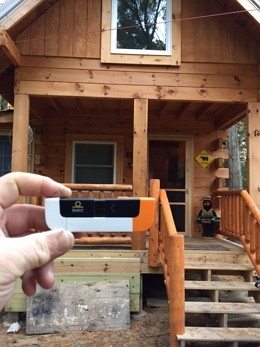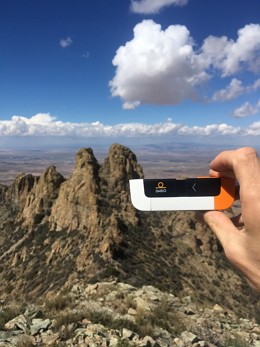Why Dario is the Perfect Exercise Companion
There is no point coming out and saying exercise is good for you — you know that. Everyone knows that. That would be a waste of time! So let’s talk about the added benefits, potential pitfalls, and why you should try to add it to your routine if you are not exercising.
But let’s first examine what is exercise. You might be thinking we’re talking about extreme triathlon training or an intense workout, but that would be false. Truth be told, we’re talking about anything that gets your heartrate up – from a brisk walk in the woods to some gardening on the weekend. When trying to incorporate exercise into your life, the goal is to pick something that you like and compliments your lifestyle.

“Even at the cabin it is important to check my blood sugars and Dario makes it easy to travel! I have been thrilled with this meter and my endocrinologist is equally as impressed.” – Paul S., on a recent trip to his cabin in Warrens, Wisconsin
When you start exercising, you burn calories and build muscle. However, for people living with diabetes, there’s an added benefit of burning calories and building muscles through exercise. That is because people who have to deal with diabetes need to be on top of managing their blood sugar levels. However, this can be challenging, especially since hypoglycemia can occur while exercising. So understanding how an exercise session—be it running, cycling or just mowing the lawn—can impact your blood glucose levels is imperative to keeping your blood sugar levels at bay so that you can successfully complete your workout, and stay healthy and fit.
In addition to giving you that svelte look, muscles store glucose and when you start moving and working out, your muscles rapidly burn glucose. So your body needs more and more fuel to pick up the slack for all the energy being burned. To counter balance this, your liver emits glucose into the bloodstream to give your body an extra dose of energy. Fat cells are also released from special cells called adipocytes. When the glucose and fat cells reach your muscles, your muscles use this fuel to give your body the necessary energy it needs.[1]
When you start exercising, your blood glucose levels can rise briefly before they start to go down – after about 30 minutes of exercise.[2] And since your blood glucose levels can shift during periods of exercise, it is advisable to test with your Dario™ Blood Glucose Monitoring System before and after your workouts.
Besides accuracy and ease-of-use, the beauty of Dario while exercising is its all-in-one approach, making it the perfect exercise companion. Slip it into your running shorts or the back of your cycling shirt, and you are empowered to check your blood glucose levels wherever you happen to be and whenever you need it. Or use Dario on a hike like David L., who loves climbing the Florida Mountains outside of Deming, New Mexico. He recently told Dario that this mountain range is one of his favorite places to go for a challenging hike and without Dario he might as well stay at home.

“Dario helps me keep my sugars up for the entire 7 hours it takes to do the peak. Thanks a ton!” – David L., Florida Mountains outside of Deming, New Mexico
Remember, if your blood sugar levels are high before you begin exercising, then wait until your blood glucose levels go back down to an acceptable level.[3]
How a workout or a run can affect your blood glucose depends on many factors including how long and how intensely you are working out. As mentioned above, the main issue with working out when you have diabetes is hypoglycemia, so be sure to consult with your physician as to what is the best way to build your workout. Furthermore, when you’re equipped with the personal diabetes log in the Dario app, your doctor or diabetes educator can better understand your glucose behavior and how to adjust an exercise program that fits your personal needs.
Exercise may lower your blood glucose for as long as 24 hours or more even after you have stopped as it increases your body’s sensitivity to insulin. This is another key reason that you should test before, after, and during your workout if you feel any symptoms of a hyper or hypo event. [4]
And let’s face it, hypos happen, so let’s be prepared to handle it effectively—especially if you are out alone. That’s where Dario comes in. If you do experience a hypo, the Dario app will automatically prepare a message with your GPS coordinates that you can send to your loved ones.
When you start exercising be sure to check your blood sugar regularly, especially pre- and post- exercise. By doing so, you should be able to get a better overall picture of how working out personally affects you. Yes, it can be a challenging at first, especially if you are dealing with hypos, but know you are not alone. Dario is here to make your life easier. Finally, be sure to consult with your healthcare professional before starting any new exercise routine. By knowing your numbers, they can also provide invaluable insights and get you on the right track.
Medical Disclaimer
The articles provided on this website are for informational purposes only. In addition, it is written for a generic audience and not a specific case; therefore, this information should not be used for diagnostic or medical treatment. This site does not attempt to replace the patient-physician relationship and fully recommends the reader to seek out the best care from his/her physician and/or diabetes educator.
[1] Weil, R. (2016). Managing your blood glucose during exercise. BD website.
[2] Goodwin, M.L. (2010). Blood Glucose Regulation during Prolonged, Submaximal, Continuous Exercise: a Guide for Clinicians (PDF). Journal of Diabetes Science and Technology. 4 (3) pp. 694 – 705.
[3] Joslin Diabetes Center. (2016). Exercises to Avoid When You Have Diabetes.
[4] American Diabetes Association. (2013). Blood Glucose Control and Exercise. ADA website.
DAR -0001 RevA 05/2019







